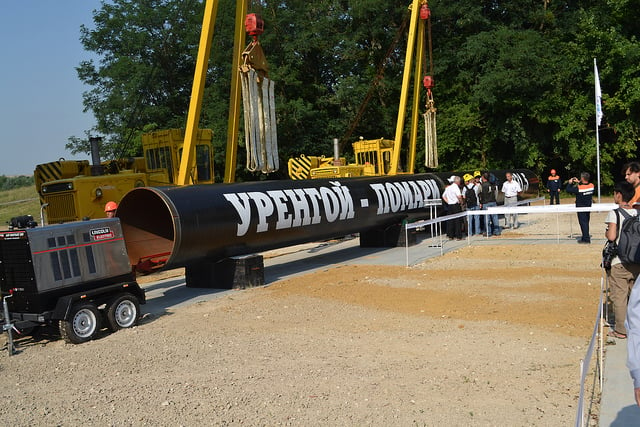May 24th, 2015
Via Foreign Policy, an interesting look at the possibility of Turkmen gas serving Europe:
Maroš Šef?ovi?, the European Commission’s vice president in charge of energy, has been hitting the old Silk Road in search of new gas supply contracts that would break Gazprom’s hold on the European market. Emerging from a meeting held in the Turkmen capital with representatives from Turkmenistan, Turkey and Azerbaijan, Šef?ovi? confidently said that the union would start importing Caspian natural gas through its long-touted Southern Gas Corridor network of pipelines by 2019. The fact that the officials also discussed the prospect of building pipeline through Iran “since diplomatic relations with Iran are developing positively” is yet another startling reminder of just how badly Europe wants to break free from Russia’s natural gas supplies.
But can the EU’s gamble pay off?
On paper, Turkmenistan would be a great match for Europe’s energy woes. To begin with, the Central Asian country sits on the world’s fourth largest gas reserve and owns the world’s second largest gas field. Historically, thanks to some perverse pipeline politics that forced the country to export the bulk of its natural gas to Russia, Turkmenistan had been one of Gazprom’s largest suppliers of gas. That is, until 2009, when the Russians unilaterally announced that they will gradually phase out gas imports from Central Asian countries (in 2015, Gazprom will buy only 4 billion cubic meters, down from 45 bcm six years ago). As a result, Ashgabat turned to China and the EU to offset the lost revenues. After Turkmen officials revealed their desire to supply Europe with 10 to 30 bcm per year, Brussels listened and quickly dispatched Šef?ovi? to Ashgabat.
What’s more, sealing a deal with Turkmenistan to send part of its gas to Europe would be a boon not only for the Union’s energy security but also for Ukraine’s own trials and tribulations with Russia. In late March, Poroshenko signaled his interest in resuming inexpensive gas imports from Turkmenistan, as a way to sidestep Gazprom’s whimsical pricing policy.
Kyiv’s energy policy used to be prescribed by the gas prices demanded by Gazprom, a price curve that ebbed and flowed in lockstep with Ukraine’s falling in and out of Moscow’s grace. Up until 2009, thanks to a contract signed by RosUkrEnergo’s Dmitry Firtash, Kyiv enjoyed the lowest gas prices in its historyby relying on a mix of cheaper Turkmen and Russian gas. The agreement, revolutionary at the time because it was the first time Turkmen gas would make its way directly to Europe, was shredded when Firtash’s political opponent and former gas trader, Yulia Tymoshenko cut out RosUkrEnergo from the equation and signed instead a 10-year agreement with Gazprom. Because of its variable pricing technique that saw prices rise four-fold in the span of a few years, the 2009 deal proved to be a complete mess for Kyiv. Prime Minister Arseniy Yatseniuk announced that his government is now seeking a hair-raising $16 billion in damages from Gazprom before an arbitration court in Stockholm.
Today, the prospect of importing Turkmen gas to Ukraine is trickier than it is for the EU, mostly because Kyiv needs Gazprom’s pipeline network for its transport. However, Ukraine’s rightfully combative stance with Russia makes the prospect of negotiating a deal with Gazprom a tough sell. Firtash, riding high after being cleared of graft charges by an Austrian court, in what the judge deemed to be a politically motivated trial mounted at Washington’s behest, could however end the deadlock given his long-standing business connection in both Moscow and Ashgabat.
With both Brussels and Kyiv courting Ashgabat, we are now witnessing the birth of a new energy architecture in Europe that will have long lasting impacts on Russia’s capacity to use its energy weapon for political games. Unlike its ho-hum predecessor, Jean Claude Juncker’s Commission has deftly navigated the testy waters laid at its doorstep by Moscow’s aggression in Ukraine. EU Competition Commissioner Margrethe Vestager leveled a €10 billion anti-trust case against Gazprom for unfair pricing in several Central and Eastern European countries. The move is part of the Union’s Third Energy Package that wants to bolster competition in EU energy markets through a process of unbundling, or separating pipeline ownership from gas producing companies. A win for the Commission’s litigators would deal a mortal blow to Gazprom’s bottom line and would force the company to rethink its business plan. Even if the company reached an agreement with Ankara on May 7 for the building of a pipeline across the Black Sea to Turkey, the feasibility of the project has been severely questioned.
Against this backdrop, Šef?ovi?’s and Poroshenko’s forays in Turkmenistan seem to indicate that the tide is turning against Gazprom’s old ways of doing business. The unprecedented fall in oil prices (Gazprom’s gas prices are pegged to the barrel) and the tumble of the ruble have shaved 86 percent off the company’s net profits in 2014, a trend that will continue unless the gas company adapts its European business model in order to respect European laws. In the medium term, the message is clear: Gazprom’s can no longer claim to be indispensable in Europe.
Focusing primarily on The New Seven Sisters - the largely state owned petroleum companies from the emerging world that have become key players in the oil & gas industry as identified by Carola Hoyos, Chief Energy Correspondent for The Financial Times - but spanning other nascent opportunities around the globe that may hold potential in the years ahead, Wildcats & Black Sheep is a place for the adventurous to contemplate & evaluate the emerging markets of tomorrow.

